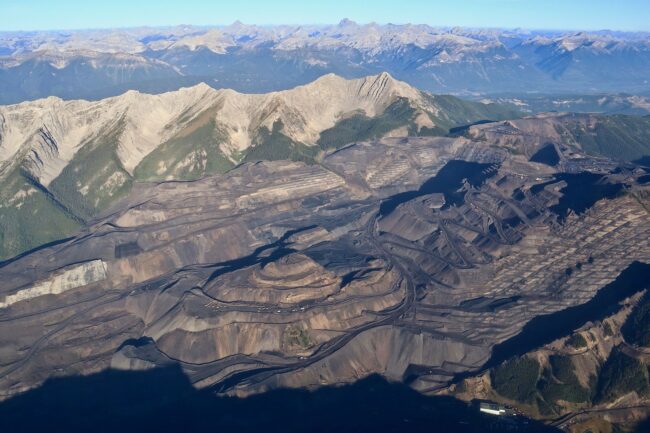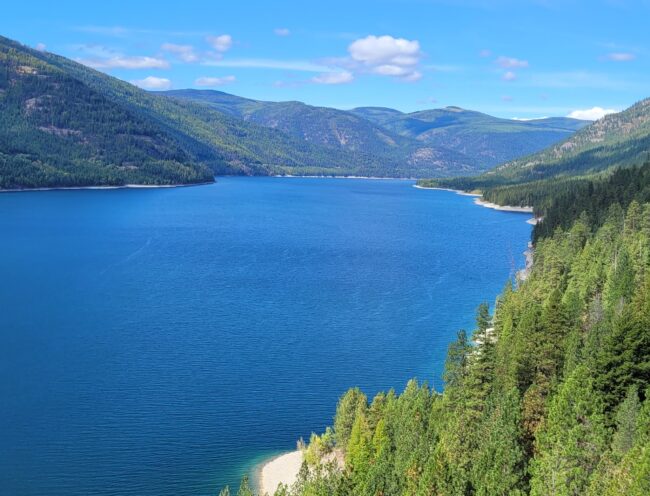By Katy Spence
Lake Koocanusa continues to be plagued by selenium pollution from Canadian coal mining, and MEIC continues to hold the line alongside a number of partners. We’ve shared updates about Koocanusa in previous issues of Down to Earth, but MEIC’s part in this campaign is just one piece of a much larger story. To tell it more fully, we have to start at the source of the pollution: in British Columbia’s (B.C.) Elk Valley.
The Selenium Problem
Wide, wild rivers meander through dramatic mountains and support a robust ecosystem full of critters such as grizzlies, wolves, and wolverines in the Elk Valley. Unfortunately, 120 years of coal mining is taking its toll on the valley, its rivers, and its inhabitants.
Teck Coal operates four active, mountaintop-removal, metallurgical coal mines that leech toxic amounts of selenium into the Elk and Upper Fording Rivers, rendering a popular fishing destination incapable of supporting healthy fish populations.
The health impacts of selenium are not insignificant. The U.S. Forest Service reports that once selenium is in water, it can bioaccumulate in food chains and become toxic to aquatic life. Selenium impacts on fish can range from subtle effects on growth to severe deformities and complete reproductive failure.
Teck has been ordered to pay several large fines for water pollution and resulting fish kills, including the largest fine imposed under Canada’s Fisheries Act: $60 million ordered in 2021. One tributary of the Elk River — the Upper Fording River — experienced a devastating 93% decrease in adult westslope cutthroat trout populations during fall 2019 (compared to 2017 levels). In addition, several towns on the Elk River have also experienced issues with selenium polluting groundwater wells, costing them millions of dollars.
Because selenium is incredibly difficult to remove from water, and rivers pay no heed to borders and complex international water pollution policy, the issue gets more complicated as waters flow south.
 There are four active mountaintop-removal coal mines in the Elk Valley, with four more proposed. Photo by Alec Underwood.
There are four active mountaintop-removal coal mines in the Elk Valley, with four more proposed. Photo by Alec Underwood.
The Montana Piece
The Elk River carries selenium pollution right into Lake Koocanusa, a 90-mile body of water that straddles the border between Montana and B.C., with just barely half its length in Montana. The Kootenai (also spelled Kootenay) River flows out from Koocanusa, through Libby and into Idaho. Both the Elk and Kootenai Rivers are culturally and ecologically significant, especially to the Ktunaxa Nation, including Confederated Salish and Kootenai Tribes in Montana and the Kootenai Tribe of Idaho, who have always advocated for protecting and restoring these waters.
In fact, in 2020, the Montana Department of Environmental Quality (DEQ) published water quality standards for how much selenium the state would allow in Lake Koocanusa and the Kootenai River. The U.S. Environmental Protection Agency (EPA) has established a national selenium standard of 1.5 micrograms per liter (µg/l) in the U.S., but it also recognizes that the one-size-fits-all standard would not work for all places and developed a process in which states could establish site-specific standards that would be protective of beneficial uses of water. The EPA is also ultimately responsible for approving state standards for selenium.
Over the course of several years, DEQ worked in accordance with the EPA’s national criteria alongside a group of stakeholders, comprised of the B.C. Ministry of Environment & Climate Change Strategy, U.S. Fish & Wildlife Service, U.S. Geological Survey, University of Saskatchewan, Tribes, and an environmental consultant for Teck Coal, to develop a site-specific selenium standard of 0.8 µg/l for Lake Koocanusa in Montana. The B.C. Province was present at most meetings, but did not sign on for the final site-specific standard. Ultimately, the Montana Board of Environmental Review (BER) adopted the 0.8 µg/l standard in the waning days of the Bullock Administration, and EPA approved the standard.
Because members of the BER are appointed by the Governor, a majority of its current members were appointed by newly-minted Gov. Greg Gianforte in 2021. In a surprising turn of events, Teck Coal successfully lobbied the new BER to attempt to rescind its selenium rule and to send a letter to EPA claiming that Montana’s new standard was adopted illegally and should be voided. BER is a quasi-judicial agency with a stated mission to protect the health, safety and interests of our state and our people. Curiously, BER is administratively attached to DEQ; yet DEQ objected repeatedly to BER’s attempts to rescind the rule.
So where does this leave Montana’s standard, and does it apply to Teck? For now, EPA considers Montana’s 0.8 µg/l for selenium the correct standard. Additionally, MEIC, the Clark Fork Coalition, Idaho Conservation League, and Idaho Rivers United, filed a legal challenge against BER in May in Montana’s 1st Judicial District Court in Helena for attempting to unlawfully void Montana’s standard. MEIC is represented by Earthjustice in this suit. DEQ has also separately sued its own BER over its attempt to void the standard, and the two cases have been consolidated.
 Also known as the Koocanusa Reservoir, this lake was created in 1972 when the Libby Dam was completed on the Kootenai River and flooded hundreds of forest acres, an Indigenous cemetery, an abandoned town, and more. A Whitefish woman named the lake as part of a contest by combining the words Kootenai, Canada, and USA to get the name: Koo-can-usa.
Also known as the Koocanusa Reservoir, this lake was created in 1972 when the Libby Dam was completed on the Kootenai River and flooded hundreds of forest acres, an Indigenous cemetery, an abandoned town, and more. A Whitefish woman named the lake as part of a contest by combining the words Kootenai, Canada, and USA to get the name: Koo-can-usa.
Photo by Katy Spence.
What’s Next
As if agency capture and devastating impacts to ecosystems weren’t enough, Teck has proposed at least three additional mines on the Elk River in B.C. This wouldn’t even be legal south of the border under the U.S.’ Clean Water Act, yet it seems perfectly legal in B.C. Unfortunately, Montana and Idaho waterways will also suffer the consequences of increased coal mining in the Elk Valley.
Ktunaxa Nation, including Confederated Salish and Kootenai Tribes in Montana and the Kootenai Tribe of Idaho, is calling for an International Joint Commission (IJC) reference to help provide a framework for enforcing regulations and working with entities on both sides of the border. The IJC is a bi-national organization established by the U.S. and Canada under the Boundary Waters Treaty of 1909. The IJC’s Rob Sisson spoke at Montana’s Water Policy Interim Committee in October, recommending to Montana legislators that an IJC reference would be beneficial for helping all parties feel heard and move forward with common solutions.
For MEIC’s part, we will continue to hold the line and push for enforcement of the site-specific selenium standard in Lake Koocanusa, as well as support the Tribes and other organizations working to prevent more pollution and damaging coal mining, through an IJC and otherwise.
This article was published in the December 2023 issue of Down To Earth.

